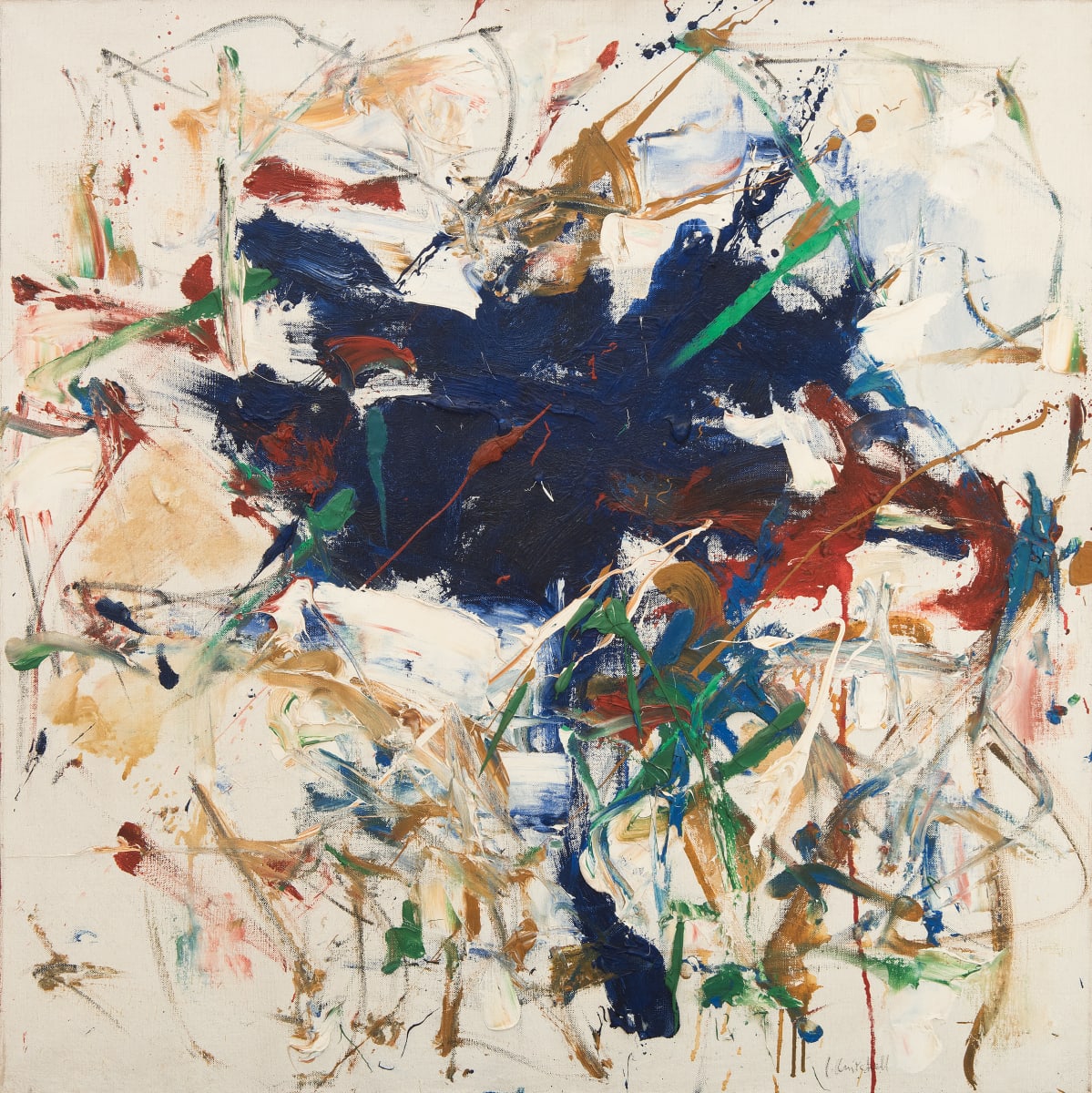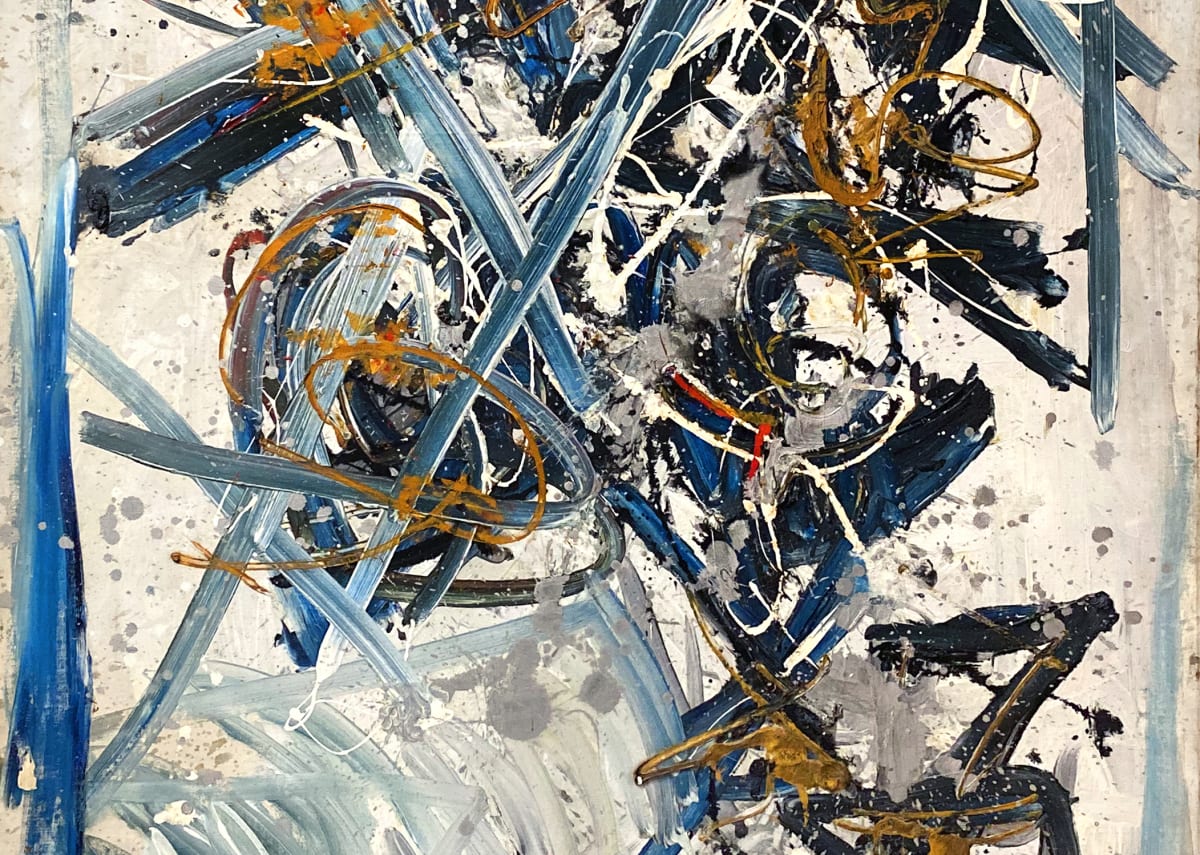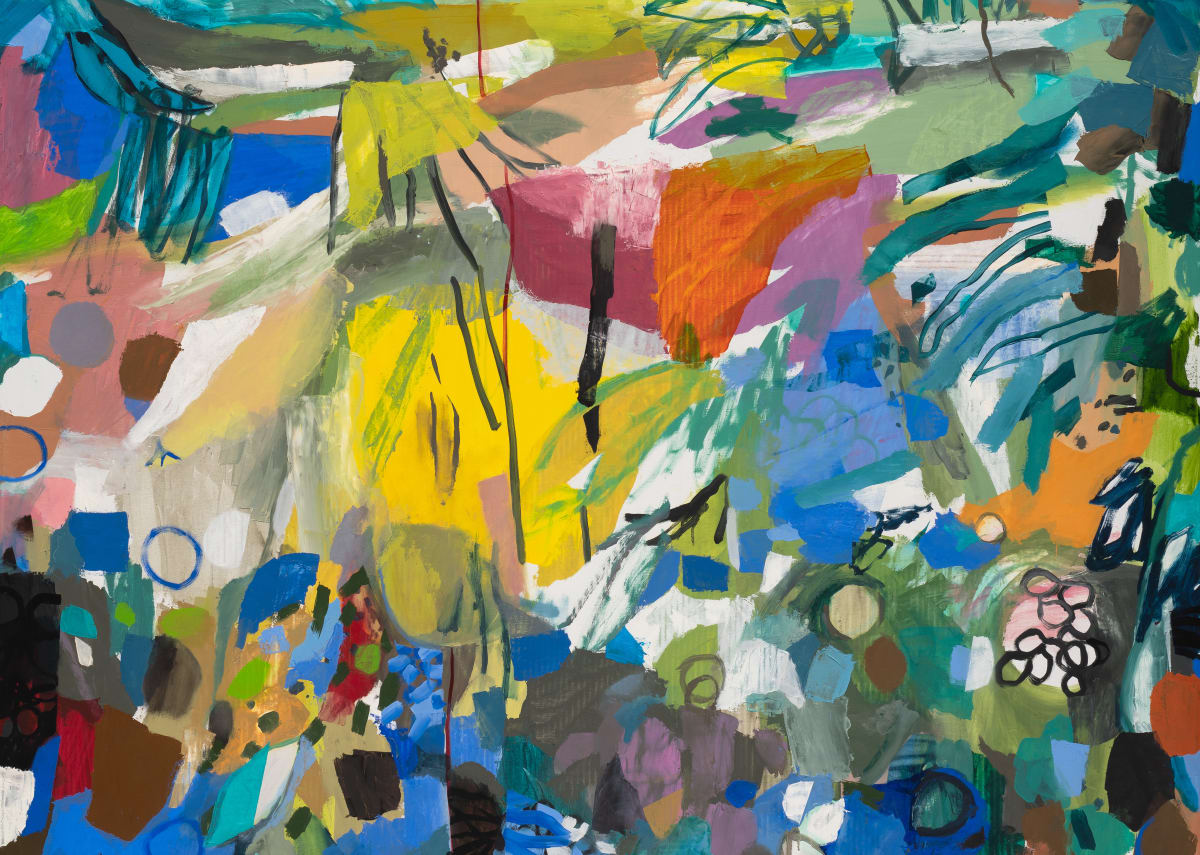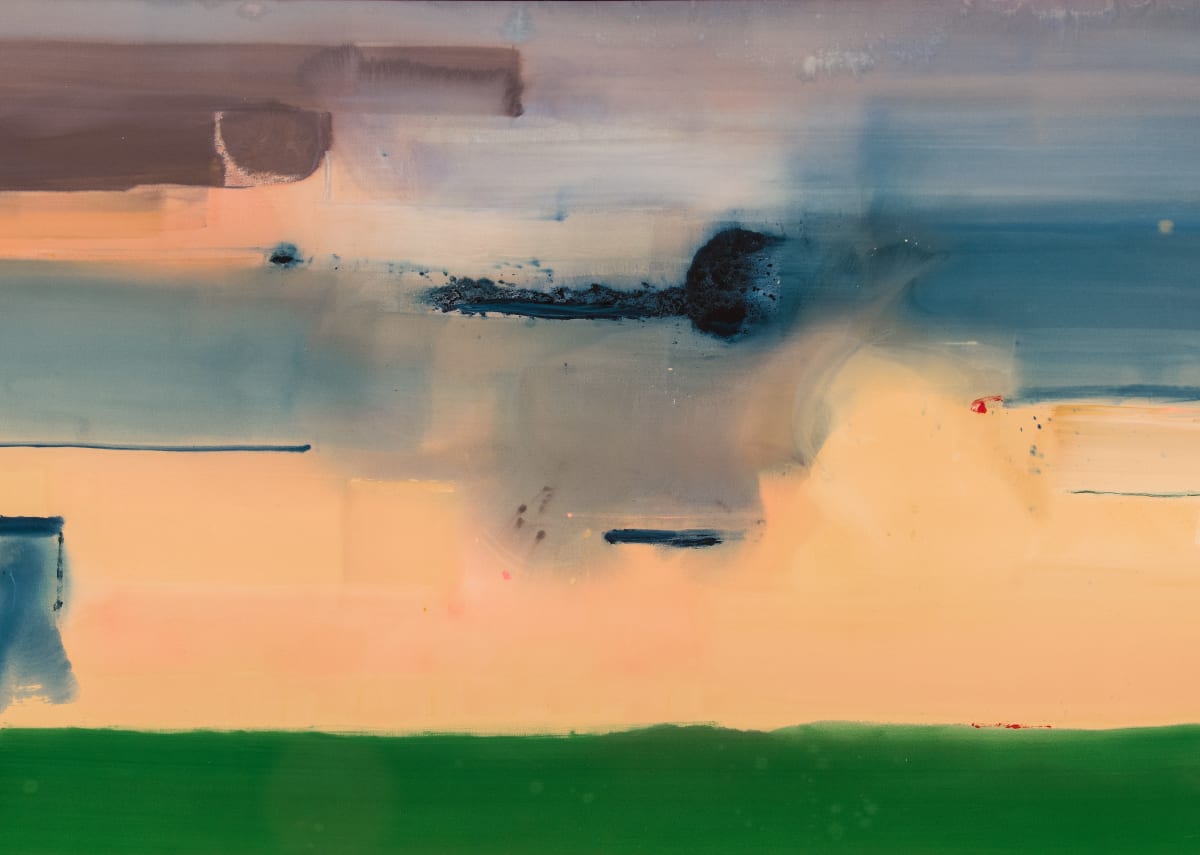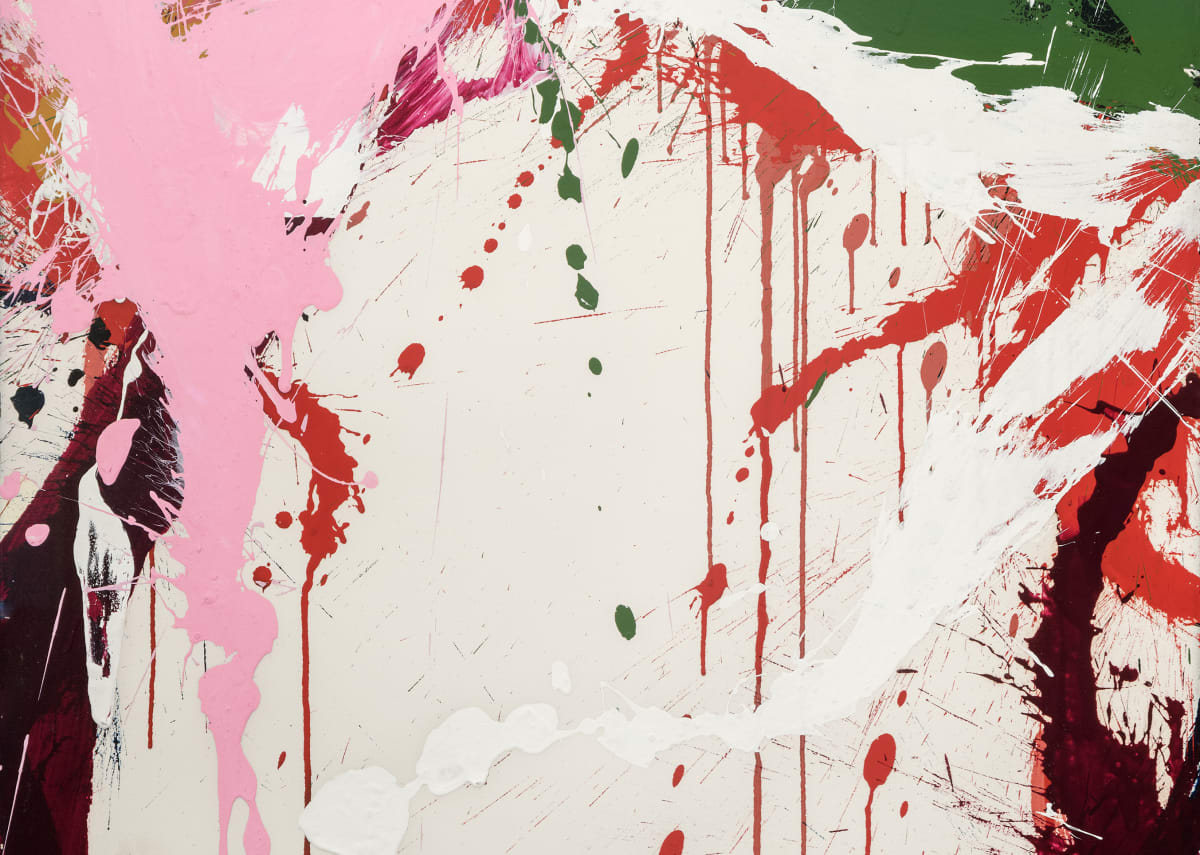
Mitchell did not wish to create a realistic view of nature, but rather to paint its effects, “what it leaves me with,” through the use of colors and brushstrokes that would evoke the sensations of landscapes.
Joan Mitchell is perhaps best known as a second-generation member of the New York School. Yet although she was included in the celebrated 1957 exhibition Artists of the New York School: Second Generation at the Jewish Museum in New York, Mitchell lived and worked primarily in France. While her dramatic, lushly painted works possess an active, gestural quality that connects her work to New York School artists such as Willem de Kooning, Franz Kline, and Philip Guston, her work also evokes the paintings and pastels of French Impressionists through their vivid palette and frequent references to nature. As her work incorporated both of these influences, Mitchell is frequently termed an Abstract Impressionist. Such an association is reinforced by the fact that Mitchell work primarily out of Vétheuil, a town outside of Paris where Claude Monet lived and worked, and in a strange twist of fate, that she also lived on Avenue Claude Monet.
Joan Mitchell is perhaps best known as a second-generation member of the New York School. Yet although she was included in the celebrated 1957 exhibition Artists of the New York School: Second Generation at the Jewish Museum in New York, Mitchell lived and worked primarily in France. While her dramatic, lushly painted works possess an active, gestural quality that connects her work to New York School artists such as Willem de Kooning, Franz Kline, and Philip Guston, her work also evokes the paintings and pastels of French Impressionists through their vivid palette and frequent references to nature. As her work incorporated both of these influences, Mitchell is frequently termed an Abstract Impressionist. Such an association is reinforced by the fact that Mitchell work primarily out of Vétheuil, a town outside of Paris where Claude Monet lived and worked, and in a strange twist of fate, that she also lived on Avenue Claude Monet.
Mitchell was born in 1926 in Chicago, Illinois. Her father, James Herbert Mitchell, was a prominent dermatologist, eventually becoming the president of the American Dermatological Association, and an amateur artist. Mitchell’s mother, Marion Strobel was an artist and a poet, editing Poetry magazine with Harriet Monroe. Through her mother, Mitchell met celebrated poets, such as Ezra Pound, T.S. Eliot, Dylan Thomas, Edna St. Vincent Millay, and Thornton Wilder, many of whom published their first work in the journal. Like her mother, Mitchell had a lifelong love of literature, with a particular passion for poetry. Mitchell also began to explore art, initially working in pencil at the age of five. She had her first show at twelve, exhibiting casein painting at the Francis W. Parker School, a progressive school in which she was enrolled. While only in the eighth grade, Mitchell sold her first work, which, significantly, was a landscape. Mitchell experimented with landscapes and depictions of nature, often working en plein-air, while simultaneously analyzing works by artists such as Henri Matisse, Paul Cézanne, Edouard Manet and Francisco de Goya displayed at the Art Institute. She felt a particular affinity with Vincent Van Gogh, a lifelong favorite whose work would continue to influence Mitchell throughout her career.
Mitchell attended Smith College, where she concentrated in English and studied art with Hyman George Cohen between 1942 and 1944. After two years, she transferred to the School of the Art Institute of Chicago, where she studied painting with Robert von Neumann and Louis Ritman and worked in a figurative manner. Mitchell’s art reflected the influence of a wide variety of artists, including Matisse and Cézanne, and Mexican muralists, such as David Alfaro Siqueiros and Jose Clemente Orozco, both of whom she met on a trip to Guanajuanto, Mexico. While at Chicago, she received the Edward L. Ryerson Traveling Fellowship before graduating with a B.F.A. in 1947. That same year, Mitchell moved to New York City to study with Hans Hofmann. Although impressed by his paintings, she ultimately decided not to enroll in his class. During this period, Mitchell saw works produced by New York School artists such as Arshile Gorky and Jackson Pollock, but later said that she was not yet able to appreciate them.
The Ryerson Fellowship allowed Mitchell to work in Paris and Le Lavandou, a town in the south of France, for one year. She traveled with Barney Rosset, a childhood friend and her future husband who later, in 1951, founded Grove Press, an avant-garde publishing house. In Paris, Mitchell associated with artists such as Herbert Katzman and Philip Guston, who had earlier judged her work favorably in a competition in Chicago. During this period, Mitchell produced Cubist inspired works that reflected the influence of Picasso. Later that year, Mitchell and Rosset relocated to Le Lavandou for the winter. There, Mitchell painted what she called “expressionist landscapes”— increasingly abstract works that were far removed from her earlier, more figurative work.
Mitchell returned to New York City in 1950 and met several prominent Abstract Expressionist artists, such as Franz Kline and Willem de Kooning, whose painting, Excavation, had profoundly impressed her. Mitchell began associating with more Abstract Expressionists and was invited to join the Artists’ Club, an exclusive organization that sponsored several important group exhibitions. Mitchell, along with artists Elaine de Kooning, Helen Frankenthaler, and Lee Krasner, were amongst the few women artists invited to join the club. In 1951, Mitchell presented a painting, Untitled (1950) in the “Ninth Street Show,” an exhibition organized by the club and curated by Leo Castelli. The other members praised Mitchell’s work, helping establish her reputation as one of the most promising young artists in New York. The following year, she would have her first solo exhibition in New York City.
Mitchell returned to Paris in the summer of 1955, where she met a group of artists which included Sam Francis, Norman Bluhm and Canadian artist Jean-Paul Riopelle. Divorced from Rosset, she and Riopelle would live together until 1979. Mitchell continued to exhibit in New York, dividing her time between New York and Paris until she eventually relocated to France in 1959. Her works made during this period, such as Ladybug (1957) challenged many of the ideas of the New York School. Although such works were abstract, she saw them as dealing with nature and representing the outside world rather than an interior one, and declared that her works “were about landscape, not about me.” Yet Mitchell did not wish to create a realistic view of nature, but rather to paint its effects, “what it leaves me with,” through the use of colors and brushstrokes that would evoke the sensations of landscapes. In contrast action painting, which, at the time was described as being primarily instinctual, Mitchell’s works were carefully composed, combining both planning and intuition. Despite the aesthetic of spontaneity that Mitchell employed in her work, she rejected the idea that her works reflected “action” painting, stating, “the freedom in my work is quite controlled. I don’t close my eyes and hope for the best.”
Mitchell’s work has been widely exhibited in the United States and Europe. In 1974, the Whitney Museum of American Art had a ten-year retrospective of Mitchell’s work and in 1982, she had a solo exhibition at the Musee d’Art Moderne de la Ville de Paris. In 1988, the Herbert F. Johnson Museum of Art at Cornell University mounted a major retrospective exhibition of her work that traveled to several venues, including the Corcoran Gallery of Art, the San Francisco Museum of Art, and the Albright-Knox Art Gallery. In 2002, the Whitney Museum of American Art recently featured her work in a posthumous exhibition. Over a decade after her death, Mitchell’s distinctive work continues to influence several generations of artists.
News










